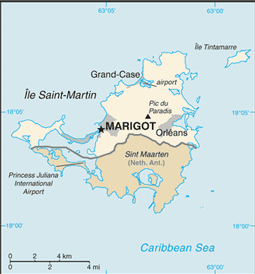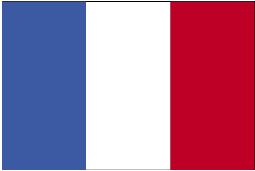
|
Saint Martin
Background:
Although sighted by Christopher Columbus in 1493 and claimed for Spain, it was
the Dutch who occupied the island in 1631 and set about exploiting its salt
deposits. The Spanish retook the island in 1633, but continued to be harassed
by the Dutch. The Spanish finally relinquished St. Martin to the French and
Dutch, who divided it amongst themselves in 1648. The cultivation of sugar cane
introduced slavery to the island in the late 18th century; the practice was not
abolished until 1848. The island became a free port in 1939; the tourism
industry was dramatically expanded during the 1970s and 1980s. In 2003, the
populace of St. Martin voted to secede from Guadeloupe and in 2007, the
northern portion of the island became a French overseas collectivity.
Location:
Island 300 km southeast of Puerto Rico. Area: Total: 4.4 sq km.
Area - comparative: 1/3 the size of Washington, DC.
Coastline: 59.8 km.
Climate and Terrain:
Climate: Temperature averages 80-85 degrees all year long; low humidity, gentle
trade winds, brief, intense rain showers; July-November is the hurricane
season.
Elevation extremes: Lowest point: Caribbean Sea 0 m highest
point: Pic du Paridis 424 m.
Natural resources: Salt.
People:
Population: 28,820
Ethnic groups: Creole (mulatto), black, Guadeloupe Mestizo (French-East Asia),
white, East Indian.
Religions: Roman Catholic, Jehovah's Witness, Protestant, Hindu.
Languages: French (official language), English, Dutch, French Patois, Spanish,
Papiamento (dialect of Netherlands Antilles).
Government:
Overseas collectivity of France
Capital: Marigot
Economy overview:
The recent changes in the EU import preference regime and
the increased competition from Latin American bananas have made economic
diversification increasingly important in Saint Martin. Improvement in the
construction sector and growth of the tourism industry helped expand GDP in
1998-99. The agriculture sector registered its fifth year of decline in 1997
primarily because of a severe decline in banana production. The manufacturing
sector is the most diverse in the Eastern Caribbean, and the government is
beginning to develop regulations for the small offshore financial sector.
GDP - composition by sector: Agriculture: 1% Industry: 15% Services: 84%.
Labor force: 43,800.
Labor force - by occupation: 85% directly employed in tourist industry.
Industries: Tourism, light industry and manufacturing, heavy industry.
Statistics:
Radio broadcast stations: AM 0, FM 3.
Airports - with paved runways: 1.
Return to Visiting Locations
|

